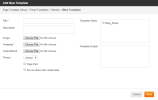
Page Templates are used to manage the structure and display of website content.
In the Page Templates Library, you perform the following tasks:
For better organization, you should create separate folders in the Page Template Library for page parts and templates.
To make it easier for content authors to associate a template with the template approach document, it is helpful to give each template (not page part) a prefix of TXX. For example, you might have T01–Home.
A page part should be created if the elements in the page part will be included in more than one template. For example, you might want to make the footer of the site a page part. However you would not make the homepage brand tile a page part as it will never be used again.
Templates should be associated with thumbnails to make them more easily identified in iAPPS. Thumbnails should be 75 pixels by 75 pixels and highlight the main areas of each template so they are easily identifiable within iAPPS.
For all these tasks ensure you are in the Page Templates Library by selecting Manage Site Assets > For Developers > Page Templates from the main navigation menus.
Only Site and Content Administrators can manage the Template Library.
The Page Templates screen displays the following:
The Styles screen displays the following:
The listing displays the following information about each file:
| Title | Name of template in CMS (users will use this to choose templates) |
| Description | Brief explanation of the contents or use of this file |
| File Name | Name of physical .ascx file associated with the template |
| Upload Data | The user who last uploaded or edit the file and the date it was uploaded/edited |
| Status | If the file is Active or Archived |
| Page Part | True if the file is a page part. |
Active files can be selected to create a page. Archived templates files exist in the library but cannot be selected to create a page.
You can add a new template file or edit its properties, and re-upload new files (with the same name) to replace existing ones.

| Title | Name of template in CMS |
| Description | Brief explanation of the contents or use of the template |
| Image | A thumbnail image or icon that will help users recognize and pick the template from the template listing when creating a page. Click Browse to upload. Thumbnails should be 75 pixels by 75 pixels and highlight the main areas of each template so they are easily identifiable within iAPPS. |
| Template | Template file name (.ascx ). Click Browse to upload or re-upload. |
| Code-Behind | Code-behind (.cs) file associated with the template. Click Browse to upload or re-upload. |
| Theme | Choose any relevant themes this would be limited to from the dropdown list. |
| Template Styles | Check the box next to any of the styles you wish applied to the template. |
| Template Scripts | Check the box next to any of the scripts you wish applied to the template. |
| Page Part | Click checkbox to indicate that the file is a page part: a template used in other templates. |
| Variant Sites | Click this checkbox if you want to limit use of the template to only a master site, rather than any variant sites. |
If your ASCX file calls a code-behind file, that file must be placed on the server, even if it contains no custom code. Otherwise the iAPPS page you create from the ASCX template will be blank. Always include a C# code-behind file for each page template and page part, and upload to the server with your template.
Page Parts are ACSX files that are meant to be used by some parent page; they should not be available for content authors to select as page templates. These are typically the common ACSX files that are used in multiple page templates, but they may also contain custom code that is embedded into an iAPPS page template.
Page element ASCX files, such as the header.ascx and footer.ascx files, should have the Page Part check box checked in their properties display.
Page templates that are meant to be used by authors to create pages should not have the Page Part check box checked.
To view which pages are using a template:
A Pages Using [template file] dialog appears, displaying either:
- A list of the pages using the selected file OR
- A message indicating that no pages reference the selected file
Content Manager does not delete an archived page template, but makes it unavailable by moving it to an archived folder.
To archive/make active a template:
If a page template is active, it appears in the Page Template library list with a status of Active, and displays in the Template list for users creating new pages.
Inactive templates cannot be used to create new pages.
To download existing template files as a zip file: